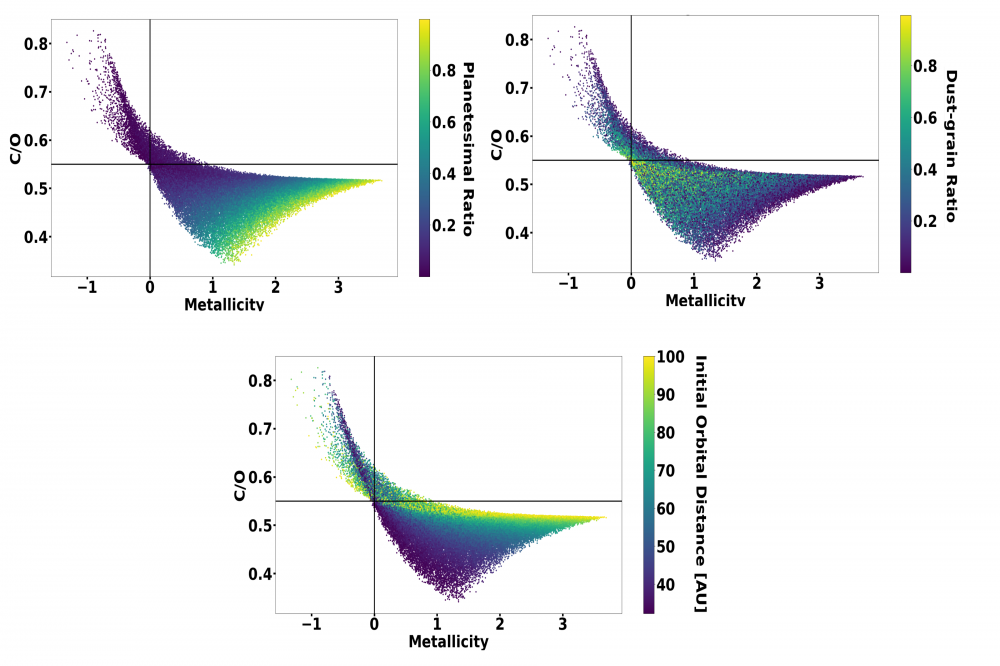Planet formation and its effect on planetara atmosphere composition
- 1Anton Pannekoek Institute for Astronomy, University of Amsterdam
- 2SRON Uttecht, Exoplanets, Netherlands
- 3St Andrews University School of Physics & Astronomy
The composition of a planet atmosphere is heavily influenced by the planet formation process and subsequent evolution. In this context, planet formation models can provide us with vital information on how different assumptions and conditions would affect the planet compositions. The combination of these models with atmospheric models are then very strong tools to help us interpret observations and connect atmospheric traits to the planet formation model.
In this work, we developed a framework that uses models for protoplanetary disks and planet formation that parametrizes the inputs in simple manners and forms giant planets with their atmospheres. Using this framework, we simulate a large population of planets with the same final planet mass and orbit distance, with different initial forming conditions. This allows us to study the trends that explain how the formation process affects the composition of giant planets. Our simulation allows us to study the effects of migration and in situ formation on the planet composition. Figure (1) shows a hundred thousand planets with one Jupiter mass at a distance of 0.02 AU. Each point on these plots represents a different initial condition. Top right plot shows the influence of the amount of dust grains, solids with a stokes number less than one, on the metallicity and the C/O ratio. Top left plot shows the influence of planetesimals, solids with a stokes number much higher than one, on the metallicity and C/O ratio. Th bottom plot shows the influence of the initial orbital distance on the C/O ratio and the metallicity of the planet.

This plot shows that the solid size distribution in the disk has an important role in causing the planet metallicity and C/O ratio changes between sub-solar and super solar. Planets that are formed in disks where the majority of the solids has a stokes number lower than 1, will end up with a more solar or sub-solar metallicity and solar to super-solar C/O ratio. On the other hand, planets that are formed in disks where the majority of the solid has a stocks number much higher than one, will end up with a more super-solar metallicity and sub-solar C/O ratio. In addition we show that the C/O ratio together with the metallicity of the planets with super-solar metallicity, can put a lower limit on the initial orbit where the planet initiates migration type II. In order to study planets with solar and sub-solar metallicity, we suggest that it is important to look at atomic ratios such as S/N, Si/N, Fe/N, or Mg/N.
To have a comprehensive understanding of the connection between disk and planet atmospheres, we couple our model describe above to an atmospheric retrieval model. We retrieve the formation parameters that we introduce in our formation model from the observed spectra for different planets. We then look at how planet characteristics, such as its mass, radius, orbital distance, and atmospheric condition affect the possibility of retrieving their formation history.
Our formation model in combination with atmospheric models, provides a strong tool in combination with space missions such as ARIEL and JWST. In particular, with JWST we can obtain information about the building blocks of exoplanet atmospheres from observing the planets themselves and the disks in which they are formed and compare them to our model predictions in order to constrain planet formation scenarios from their atmospheric composition. Additionally, our model can be used to inform the target list for ARIEL as it predicts for which planets it is more likely to retrieve information about their formation history.
How to cite: Khorshid, N., Min, M., Desert, J. M., Dominik, C., and Woitke, P.: Planet formation and its effect on planetara atmosphere composition, European Planetary Science Congress 2021, online, 13–24 Sep 2021, EPSC2021-660, https://doi.org/10.5194/epsc2021-660, 2021.

